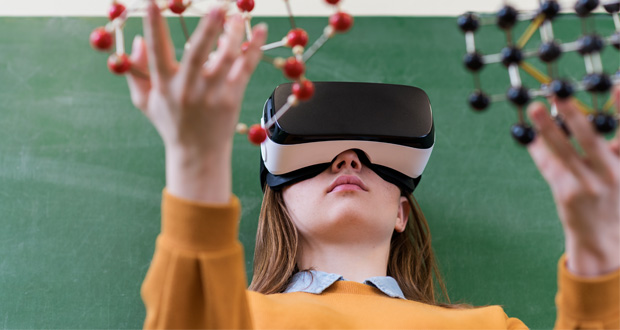“Oh, that’s what it looks like!” the student exclaims. A Year 12 biology student is in my office at lunchtime – or at least, that’s what it looks like on the surface. In her world, she’s actually inside a cell, approaching the nucleus. Things that she has only seen in diagrams are given scale and form – and suddenly it all clicks.
If you look at many classrooms today and compare them to those from the last century, you probably won’t notice much difference. From Netflix to Uber, while technology has disrupted and transformed many industries, the education world has been unshaken. Digital projectors were meant to promise new ways of teaching, but instead frequently just supported the same teacher-centric model of learning that has been around for eons.
Is virtual and mixed reality the technology that finally shakes the education world up? From the look of how virtual reality (VR) is transforming learning at Strathcona, the answer might be yes.
In the Year 10 VR Worlds classroom, students are creating businesses to build their own virtual reality game. They attended the League of Extraordinary Women’s Tech-novation conference to learn how to establish and build their business. They have designed and sourced 3D assets, created characters in Adobe Fuse and then built their game in the Unity development environment.
You might not have heard of Unity, but there’s a good chance that you’ve played a game created in it. Unity is one of the leading industry platforms and is the power behind games such as Assassin’s Creed: Identity, Monument Valley 2 and Pokemon Go. This means that by the end of the unit, students will not only have learnt industry-level skills, but they can also start selling the game that they make – the business they start in school could outlast any final grade.
The skills they learn go beyond making games. How many times have you heard the phrase 'I’m a hands-on learner'? The reality is that we all learn better when we experience the problem. VR closes the feedback loop – your actions have immediate consequences, allowing you to modify your approach. This is why VR is already being used in medical training, to allow surgeons to practice and hone their approach in a safely simulated environment.
In our Junior School, Eleni Kyritsis runs VR field trips using Google Expeditions, giving students the opportunity to experience the areas they are learning about. In field trips, students take 360 photographs and tag them with their observations. Students are much more engaged, because their learning is far more relevant than a couple of photographs on a projector – they’re able to do their own investigations and explore the world in context.
VR also offers great opportunities for encouraging empathy – something that is very difficult to teach. You experience situations from the point of view of the protagonist. In the Australian-made VR film Collisions, Lynette Wallworth gives the audience the experience of an Aboriginal elder experiencing western technology for the first time. When our students create 360 films, they have to research, question and apply their understanding to communicate this empathy to others. It’s a whole new way to approach emotional intelligence.
This is an area that is constantly evolving, which is incredibly exciting – and also presents a challenge for educators. In February, Microsoft introduced the Hololens 2. With this mixed reality headset, the user isn’t tied to a computer. The headset generates holograms that they can control with touch and voice. You can speak to an avatar of your workmate from across the world and it will feel like you’re in the same room. The tyranny of distance disappears and you can share the same work, look at and manipulate the same model, collaborating seamlessly. This kind of technology isn’t utopian, however, and raises concerns about privacy and the impact on society.
It is the job of our schools to prepare our students for a world where this technology is not just available but is commonplace – and we can only do this if we give students the experience of safely exploring and questioning new technologies. This is what I’m trying to do at Strathcona – create women who are the not just the consumers, but responsible creators of the technology that is shaping our society.
Michelle Dennis is the head of digital learning and innovation at Strathcona Girls Grammar.
Do you have an idea for a story?Email [email protected]
 Education Review The latest in education news
Education Review The latest in education news
